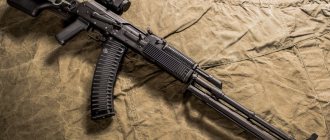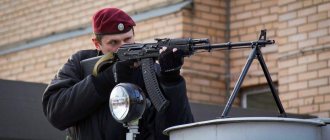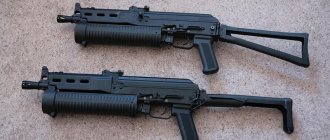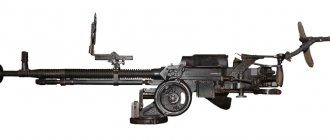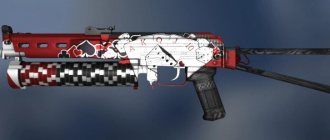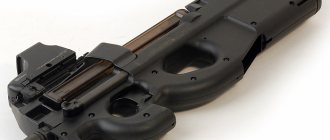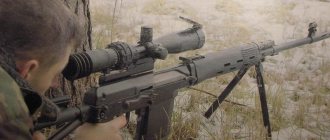Kalashnikov PKM machine gun - video
Influenced by the experience of the Second World War, in which the Wehrmacht successfully used single machine guns MG 34 and MG 42, already in 1946 (when the RP-46 machine gun was adopted) the GAU approved the tactical and technical requirements for a single machine gun to replace the Maxim and heavy machine guns. SG-43. In the USSR, the idea of a single machine gun suitable for installation on bipods and field machines was proposed by small arms designer Vladimir Fedorov in the early 1920s.
In this regard, active design of a new class of machine gun chambered for the 7.62x54 mm R rifle cartridge for the Soviet army began. The earliest projects were Georgy Garanin's machine gun from 1947 and Vasily Degtyarev's machine gun from the same year. The first option was rejected, and there was no one to finalize the second due to the death of the creator.
At the end of the 1950s, Izhevsk designers led by Mikhail Kalashnikov became involved in the process. In addition to him, the developers of the future machine gun included V.V. Krupin, V.N. Pushchin, A.D. Kryakushin and others. They took as a basis the proven design of the Kalashnikov assault rifle, which was distinguished by its reliability and simplicity.
Kalashnikov PK machine guns
The Kalashnikov machine gun (factory index E-2) was the latest project among competitors; only in 1959 did it undergo evaluation tests, unlike, for example, its main competitor - the Tula machine gun designed by Nikitin and Sokolov, which already had working prototypes in 1956. This forced the team of workers and designers to work in emergency mode, making up for lost time. The final competitive tests of 1960 revealed advantages over the Nikitin-Sokolov machine gun:
— use of standard SGM/Maxim/RP-46 tape; — less sensitive to the gap between the piston and the gas tube; - much less sensitive to soaking, which is critically necessary for use on armored vehicles, which must necessarily cross water barriers; — there is an adjustment of the locking unit, which facilitates the interchangeability of barrels; — incomparably easier to do incomplete disassembly; — less carbon pollution and more ease of cleaning the pipe; - more durable parts; - 300 grams less body weight.
On October 20, 1961, by resolution of the Council of Ministers of the USSR No. 953-405, the Kalashnikov machine gun was adopted by the army. PK and PKS (GRAU index: 6P6 and 6P3) were adopted into service by order of the Ministry of Defense No. 0287 on December 28, 1961, and PKT (GRAU index - 6P7) by order of the Ministry of Defense No. 269 on December 2, 1962.
The production of machine guns was carried out at the Kovrov Mechanical Plant.
And in 1969, a modernized PC appeared on a machine designed by Stepanov. The machine gun's weight was reduced from 9 to 7.5 kg, production and ease of use were simplified. Stepanov’s machine gun is 3.2 kg lighter than Samozhenkov’s machine, the ratio of the weight of the machine to the weight of the machine gun itself has decreased from 0.86 to 0.6, and the weight of the machine gun on the machine (without belt) is up to 12.0 kg, but the accuracy of fire is not the same worsened. Accordingly, new versions of the machine gun were designated PKM, PKMS, PKTM and PKMB. In the new competition, the PKM’s main competitor was again a machine gun designed by Nikitin, but with a different design.
Options and modifications
PC - Kalashnikov machine gun with bipod.
The PKB and PKS variants differ from the PC only in the factory configuration that determines their purpose:
— if the PC is installed on a tripod machine, it is called PKS (easel machine). - if the PC is installed on an armored personnel carrier (using a rotating bracket), then it is called PKB (armored personnel carrier). The swivel bracket is officially called the “Installation”. The machine gun was installed only on armored personnel carriers that do not have a turret (armored personnel carriers with a turret use the PKT).
The tripod machine for the PKS and the installation for the PKB had a serial number and were assigned in the unit to a specific machine gun by an entry in the form. All three machine guns (more precisely, one with three names, depending on where it is installed) were put into service in 1961 to replace the RP-46, SGM and SGMB, respectively.
A tripod machine for PKS facilitates targeted shooting of a machine gun from a bunker or trench, shooting at air targets and shooting in mountainous areas.
The installation for the PCB consists of a swivel (providing horizontal aiming), a sector (providing vertical aiming), a holder (holding a high-capacity cartridge box for 200/250 rounds), a spring shock absorber softening recoil, a frame (connecting the machine gun with the installation) and a cartridge case catcher (allowing to avoid cluttering the internal space of the armored personnel carrier). The design of the PCB included a non-removable bipod and butt as on a regular PC, which made it possible, if necessary, to use it outside the combat vehicle.
The PKB was used on armored personnel carriers that had an open-top design without a rotating turret (BTR-40, BTR-152, BRDM-1, BTR-50) as well as on the turretless early versions of the BTR-60 - BTR-60P and BTR-60PA. Since these types of armored personnel carriers were almost completely removed from service with the USSR Armed Forces, this modification is rare.
PKM is a modernized Kalashnikov machine gun. Adopted into service in 1969 to replace the PC. Differs in less weight.
PKMS and PKMB respectively .
At the same time, a new 6T5 tripod machine designed by Stepanov was adopted for use in the PKMS version. While maintaining all the positive qualities of the previous machine, it is 3 kg lighter, and in addition it has: - special belts for fastening boxes with tapes in the stowed position; thus, in the stowed position, up to 2 boxes with belts of 200 rounds of ammunition are carried along with the machine; — mounting on the legs of the machine for a box with tape in the firing position; thus, in battle, one soldier can carry a machine gun along with the machine and the cartridge box without removing the belt from the machine gun. In addition, just like in the Samozhenkov machine, the new machine can be equipped with a machine gun for anti-aircraft shooting.
PKT is a Kalashnikov tank machine gun, with a heavier barrel and equipped with an electric trigger. It is installed in the turrets of tanks and other armored combat vehicles (BMP, BMD, BTR-60PB/70/80/90, MT-LB, BMPT, BRDM-2, BRM-1K). Adopted into service in 1962 to replace the SGMT machine gun.
Kalashnikov PKM machine guns
PKTM is a modernized Kalashnikov tank machine gun. Adopted into service in 1998.
AEK-999 “Badger” - PKM with a new machine-gun barrel produced by the Kovrov Mechanical Plant. The biggest change in the weapon's design compared to the single PKM machine gun is the new non-replaceable barrel, which uses aircraft-grade materials. It is equipped with a removable low-noise firing device, which allows to significantly reduce the acoustic load on the members of the machine gun crew and reduce visibility by reducing noise and eliminating the muzzle flash. There is evidence that the sound of a shot, depending on the type and terrain, is no longer audible at a distance of 400-600 m. A heat dissipator is located above the machine gun barrel, which reduces the distorting effect of warm air on the aiming line and makes the barrel structure rigid. Barrel life is 33-40 thousand shots.
Pecheneg - PKM with a barrel of forced cooling due to the energy of powder gases. Developed at TsNIITochmash.
Type 80 - Chinese PKM. The machine gun entered service with the PLA in the 1980s in 1983. At first it was assumed that the Type 80 would replace the Type 67, previously developed in the PRC, which had proven itself well at the military district training ground in Chengdu. However, then the development was curtailed, and only the Type 67 remained in service. Several Type 80 samples were tested in the Chinese Navy, then they were modernized, and the ground forces received a modification of the Type 86, which was put into service with the PLA.
Zastava M84 - Serbian PKM. One of the differences is the stock is made of solid wood.
Design
The Kalashnikov machine gun uses gas-operated automatics; the barrel is locked using a rotating bolt. Fire is fired only in bursts, from an open bolt. In the infantry and armored personnel carrier versions, the machine gun is equipped with a folding bipod, a skeleton stock and a pistol grip fire control. In the easel version, the machine gun is mounted on a universal folding tripod machine. To fire at air targets, the machine has a special adapter rod. The sights are open and adjustable. The machine gun can also be equipped with optical or night sights. PKM of the Hungarian army
The trigger mechanism with a return spring provides only automatic fire. The gas outlet unit has a three-position gas regulator. The barrel is air-cooled, the barrel is quick-changeable and has a carrying handle for easy replacement. The cartridges are fed from a non-scattered metal tape, the tape is fed only from the right.
Incomplete disassembly of the PKM machine gun
The cartridge feed from the belt is two-stage; when the bolt group moves back, the cartridge is pulled out of the belt by the extractor grips and lowered to the feed line. Then, after pressing the trigger, the bolt group moves forward, the cartridge is sent into the barrel. The combat cock is located on the bolt frame, and the firing pin is connected to it. When, after locking the bolt, the bolt frame continues to move forward, the firing pin, under its action, moves along the channel in the bolt frame and breaks the primer. In the tank version of the machine gun (PKT), instead of a trigger, an electromagnetic trigger mechanism (electric trigger) is installed, activated by a button located on the gun pointing unit on a tank or infantry fighting vehicle or located on the turret rotation handle on an armored personnel carrier. The electric trigger is connected to the on-board network of the armored vehicle with a cable protected by a flexible tube made of twisted wire 50 centimeters long. In case of failure of the electric trigger or lack of voltage in the on-board network of the armored vehicle, the tank version of the machine gun (PKT) is equipped with a mechanical firing system. The mechanical trigger is located above the electric trigger block on the butt plate of the receiver and is represented by a horizontal trigger held by a vertical safety bar. Machine guns of the PK / PKM series are distinguished by exceptionally high reliability and enjoy deserved popularity among the troops.
PKT tank machine gun
The tank version has a heavier and longer barrel, as well as a modified gas exhaust unit to reduce gas contamination in the fighting compartment. A heavy barrel with thicker walls allows for more intense fire without replacing the barrel. The tank version lacks mechanical sights, a stock, a pistol grip and a bipod. To open fire, an electric trigger is used, connected to the on-board network.
If there is no voltage in the on-board network, in the back of the PKT receiver, above the electric trigger block, there is a mechanical trigger, made in the form of a vertical trigger, held by a spring-loaded fuse located in the horizontal plane. The fuse fits into the slots of the trigger with its protrusions, thereby securing it. In this case, to fire, you need to press the safety down and press the trigger in the direction of the shot. At the end of firing, the trigger and safety lever return to their original position under the influence of springs when the safety locks the trigger.
The only standard specialized device for PKT is the so-called Cold Sighting Tube (TCP), which serves to align the tank machine gun and sight, and is individually attached to each machine gun.
Conversion of the PKT machine gun into an infantry version
During numerous local conflicts in the early 90s, in the territory of the former USSR, representatives of illegal armed groups developed an acute demand for light machine guns as the main means of supporting infantry. At the same time, the warring parties acquired a large number of PKT machine guns, stolen from military units, taken from armored vehicles damaged in battles or disabled. A natural step to overcome such a shortage should be considered small-scale production of converting PKT tank machine guns into an infantry version in civilian mechanical workshops.
The conversion scheme that became most widespread was as follows: — The electric trigger unit was removed from the machine gun. — To the vacant space on the butt plate of the receiver, a butt with a pistol grip made of a single piece of plastic or repeatedly glued layers of plywood was attached with a riveted connection using steel plates on the sides of the receiver. — The safety bar was removed, and the partially cut trigger was connected to a homemade hook, under which a slot was cut in the bottom of the receiver. — On the barrel gas outlet assembly, a tin bracket with a bipod made of a thick steel rod with pointed ends was bolted. — A protrusion with a front sight was attached to the barrel in the front part by welding. — A steel corner with a radial cutout, which played the role of a sighting bar, was attached to the receiver cover with a riveted connection.
Due to the maximum simplification of the conversion process, the resulting machine guns did not have such elements of the PKM infantry machine gun as: a fire safety device, a bracket for attaching a box of cartridges, a safety guard on the trigger, a holder on the bipod for a prefabricated ramrod, sockets in the butt for an oil can and for a pencil case with cleaning supplies. Due to such simplifications, the converted PKT machine gun was inferior to the PKM in terms of size and weight, ease of carrying in combat, safety and accuracy of aimed fire. The only advantage of the converted PKT over the PKM was the ability to conduct more intense and prolonged fire thanks to the weighted barrel. Machine guns of a similar design were widely used during the Karabakh War, during the First and Second Chechen Wars, in the Civil War in Tajikistan, in the South Ossetian War (1991-1992), in the Georgian-Abkhaz War (1992-1993).
During the military operations in Donbass, converted PKTs were used by militias from Gorlovka and Ukrainian troops.
Production
Azerbaijan: two versions of the PKM are produced (chambered 7.62x54 mm R): the general-purpose UP-7.62 (weight 7.5 kg) and the special HP-7.62 (weight 7 kg).
Bangladesh: Produced by Bangladesh Ordnance Factories under the symbol BD-14.
Bulgaria: in 1971-1973, serial production of the PK machine gun was mastered and started, and in 1976-1978 - of the PKT tank machine gun, now PKM is produced; subsequently, modified versions of the PKM machine gun chambered for 7.62x51 mm NATO cartridge were developed;
Iran: Produced by Defense Industries Organization;
PRC: PKT is produced under the name Type 59T; The PKM is produced under the name Type 80. The export version chambered for 7.62 NATO cartridge is produced under the designation CF06 or CS/LM4;
DPRK: produced under the name Type 73 in a version with combined power supply: 30-round magazine or cartridge strip.
Poland: PKM, PKT machine guns and their modifications have been produced since 1968; after the transition to NATO standards in 1997-2000, the Tarnow Mechanical Plant developed the UKM-2000 variant chambered for 7.62x51 mm.
Russia: PKM, PKTM, PKMS, PKMB are produced;
Romania: the PKM machine gun is produced by the Romarm company (a division of the Kujira Arms Factory) under the name Mitraliera md. 66 and PKT under the name MMB;
Serbia: the PK machine gun is produced under the name Zastava M84, PKT - under the name Zastava M86;
Sudan: Manufactured by Military Industry Corporation under the name Mokhtar;
Ukraine: PKM (under the name KM-7.62) and PKT (under the name KT-7.62) are produced
Contest
As usual, experienced Soviet gunsmiths who had gone through the war and, perhaps, the best in the world, took part in the announced competition. Izhevsk residents, led by the legendary Mikhail Kalashnikov, also decided to test their strength and joined the competition, and were the very last of all. Garanin proposed his options, followed by Silin and Pererushev, and Shilin and Gryazev-Lyubimov-Kastornov machine guns were considered. The obvious favorite in this race was the Nikitin-Sokolov option. But all these projects were actively proposed until the Izhevsk residents with their PCs intervened in the competition.
Soviet soldier with PKM in Afghanistan
Source: pinterest.ru
The PC was presented later than the other participants in the competition and, traditionally for Kalashnikov, won thanks to its simple and, most importantly, reliable design. After being immersed in the water, the PC habitually began to fire in bursts, but his competitor, another finalist presented by Nikitin and Sokolov, could not. And so the matter was resolved. After long tests that were carried out since the post-war 1947, in 1961 the first domestic single machine gun PK (GRAU 6P6 index) finally appeared in the army.
Photo of the PKM machine gun
Kalashnikov PKMS machine gun on a 6T5 machine designed by Stepanov
The butt plate of the PKM stock (on the right) is equipped with a folding shoulder pad, designed for more rigid fixation of the machine gun when firing
Slotted machine gun flash suppressors (from bottom to top): PK, PKM of early releases, PKM currently in production
PKS machine gun (PK on a 6T2 Samozhenkov machine) with an ammunition box with a belt for 250 rounds
Similar
AK-47 assault rifle cartridge caliber 7.62 mm.
Device. Rate of fire AK-74 assault rifle cartridge 5.45 mm caliber. Device. Rate of fire
Dragunov SVD sniper rifle caliber 7.62 mm. Device
AKS-74U assault rifle cartridge caliber 5.45 mm. Device. Weight
Mauser K96 pistol cartridge caliber 7.63 and 9 mm. Device
Pistol Walter PP / PPK cartridge caliber 7.65 and 9 mm. Device
Pistol Yarygin PYa Grach cartridge caliber 9 mm. Device
DShK machine gun cartridge caliber 12.7 mm. Device. Rate of fire
Luger pistol R.08 Parabellum cartridge caliber 9 mm. Device
Pistol PM cartridge caliber 9 mm. Rate of fire. Dimensions. Bullet speed. Sighting range
Self-loading shotgun Saiga-12 cartridge, caliber. Device
Maxim machine gun cartridge caliber 7.62 mm. Device. Weight
PPSh-41 Shpagina submachine gun cartridge caliber 7.62 mm
APS Stechkin pistol cartridge caliber 9 mm. Device
Nagan system revolver cartridge caliber 7.62 mm. Device
Kalashnikov PK machine gun and PKM cartridge caliber 7.62 mm. Device
Simonov carbine SKS-45 cartridge caliber 7.62 mm. Device
Rifles and carbines Mauser 98 caliber 7.92 mm. Device
PPS-42 and PPS-43 Sudaev submachine gun cartridge caliber 7.62 mm
Pistol Walter P38 cartridge caliber 9 mm. Device
MP-40 German submachine gun cartridge caliber 9 mm. Device
VSS Vintorez sniper rifle caliber 9 mm. Device
Submachine gun PP-91 Kedr cartridge 9 mm caliber. Device
Light machine gun RPK-74 cartridge caliber 5.45 mm. Device
Pistol Glock 17 cartridge caliber 9 mm. Device
Makarych, Izh-79-9T, MR-79-9TM, MP-80-13T traumatic pistol
AK-12 assault rifle cartridge caliber 5.45 mm. Device. Weight
Mosin rifles and carbines Three-line caliber 7.62 mm
PMM Makarov pistol modernized 12 rounds. Device
Revolver Colt Single Action Army (SAA) Peacemaker. Device
Machine gun PKP Pecheneg cartridge caliber 7.62 mm. Device
Sniper rifle VSSK Exhaust caliber 12.7 mm. Device
Beretta pistol 92 cartridge caliber 9 mm. Device
TT - Tokarev pistol cartridge caliber 7.62 mm. Device
Submachine gun PP-19 Bison cartridge caliber 9 and 7.62 mm. Device
Sniper rifle SV-98 caliber 7.62 mm. Device
Vladimirov KPV machine gun cartridge caliber 14.5 mm. Device
ASH-12 assault rifle cartridge caliber 12.7 mm. Device. Rate of fire
PSM pistol cartridge caliber 5.45 mm. Device
Pistol Colt M1911A1 cartridge caliber 45. Device
Smith-Wesson revolver Russian cartridge, caliber 10.67 mm. Device
Degtyarev DP-27 light machine gun, 7.62 mm caliber cartridge. Device
Shotgun Mossberg 500 Cartridge. Dimensions. Rate of fire. Sighting range
Thompson submachine gun cartridge caliber 11.43 mm. Device
Pistol USP Heckler und Koch cartridge, caliber. Device
Hunting carbine OSK-88 (SVT-40) caliber 7.62 mm. Device
AS Val silent automatic cartridge caliber 9 mm. Device
Submachine gun PP-19-01 Vityaz cartridge 9 mm caliber. Device
Machine gun Kord cartridge caliber 12.7 mm. Device. Weight. Sighting range
Osa - traumatic pistol cartridge, caliber. Device
AK-9 assault rifle cartridge caliber 9 mm. Device. Rate of fire
Degtyarev RPD light machine gun, 7.62 mm caliber cartridge. Device
Automatic OTs-14 Groza cartridge caliber 9 mm and 7.62 mm. Device
Czech pistol CZ-75 (modifications). Device
Browning pistol 1903 cartridge caliber 9 mm. Device
Sniper rifle OSV-96 caliber 12.7 mm. Device
FN P90 submachine gun cartridge caliber 5.7 mm. Device
Submachine gun OTs-02 Cypress cartridge caliber 9 mm. Device
Sniper rifle ASVK Kord caliber 12.7 mm. Device
Automatic AEK-971 Cartridge. Caliber. Device. Rate of fire
Steyr AUG assault rifle (A1, A2, A3) cartridge caliber 5.56 mm
AK series 100 assault rifles. Modifications. Device. Weight. Dimensions
Uzi submachine gun. Cartridge. Caliber. Rate of fire
Pistol SR1M Gyurza cartridge caliber 9 mm. Device
Pistol GSh-18 cartridge caliber 9 mm. Device
SVDK sniper rifle caliber 9.3 mm. Device
Automatic SR-3M Whirlwind cartridge caliber 9 mm. Device
Machine gun NSV-12.7 Utes cartridge, cal. Device. Weight
Kalashnikov RPK light machine gun cartridge caliber 7.62 mm. Device
Sniper rifle VSK-94 caliber 9 mm. Device
Vostok-1 (Jorge-3M) 9mm caliber traumatic pistol. Device
Degtyarev PPD submachine gun cartridge caliber 7.62 mm
English sniper rifle L96A1 cartridge, caliber
M1 Garand rifle cartridge caliber 7.62 mm. Device
Desert Eagle pistol. Device
Smith-Wesson revolver (modifications). Device
Automatic rifle HK G36 (E, K, C, KE) cartridge caliber 5.56 mm
Pistol P-96 cartridge caliber 9 mm. Device. Rate of fire
Pistol GP35 Browning High Power cartridge, caliber. Device
Assault rifle FN SCAR (L, H) cartridge caliber 5.56 and 7.62 mm
Revolver Lefoshe M1856 cartridge caliber 11 mm. Device
Submachine gun PP-90 cartridge caliber 9 mm. Device
AN-94 Abakan automatic Nikonov cartridge caliber 5.45 mm. Device
Submachine gun PP-2000 cartridge caliber 9 mm. Device
Mauser pistol HSc cartridge caliber 7.65 and 9 mm. Device
M16 automatic rifle cartridge caliber 5.56 mm. Device
Fedorov assault rifle cartridge caliber 6.5 mm. Device. Rate of fire
Pistol Baltiets cartridge caliber 7.62 mm. Device
Strizh pistol cartridge caliber 9 mm. Device. Weight. Sighting range
Browning pistol 1910 cartridge caliber 7.65 and 9 mm
Silent pistol PSS Vul cartridge caliber 7.62 mm. Device
Pistol SIG-Sauer P226 cartridge caliber 9 mm. Device
Pistol OTs-27 Berdysh cartridge caliber 7.62 mm and 9 mm. Device
AK-107 assault rifle cartridge caliber 5.45 mm. Device. Rate of fire
OTs-44 sniper rifle, caliber 12.7 mm. Device
German machine gun MG3 cartridge caliber 7.62 mm. Device
Self-loading shotgun Browning Auto-5 cartridge, caliber. Device
Submachine gun AEK-919K Kashtan cartridge caliber 9 mm. Device
PB pistol silent cartridge 9 mm caliber. Device
Pistol OTs-33 Pernach cartridge caliber 9 mm. Device
Hunting carbine KO-98 cartridge caliber 7.92 mm. Device
TK (Korovin pistol) caliber 6.35 mm. Device. Weight. Dimensions
Underwater assault rifle APS cartridge caliber 5.66 mm. Device
Pistol OTs-21 Malysh cartridge caliber 9 mm. Device
American M60 machine gun, 7.62 mm caliber cartridge. Device
MTs-116M sniper rifle, caliber 7.62 mm. Device
Automatic 9A-91 cartridge caliber 9 mm. Device. Rate of fire
Submachine gun PP-93 cartridge caliber 9 mm. Device
VAG-73 - Gerasimenko pistol. Device. Weight. Dimensions
Cordon-5 is a traumatic pistol. Device. Weight. Dimensions
Goryunov SG-43 heavy machine gun cartridge caliber 7.62 mm. Device
Webley revolver cartridge, caliber. Device. Dimensions. Weight
Machine gun AEK-999 Badger cartridge caliber 7.62 mm. Device
RP-46 machine gun, 7.62 mm caliber cartridge. Device. Rate of fire
Sniper rifle VS-8 cartridge caliber 8.6 mm. Device
Slostin machine gun cartridge caliber 7.62 mm and 14.5 mm. Device
Assault rifle Tavor TAR-21 cartridge caliber 5.56 and 5.45 mm
Submachine gun SR-2 Veresk cartridge caliber 9 mm. Device
Lancaster pistol cartridge caliber 12.1 mm. Device. Rate of fire
Submachine gun PP-90M1 cartridge caliber 9 mm. Device
Underwater pistol SPP-1M. Device. Weight. Dimensions
Traumatic pistol MP-461 Guard. Device. Weight. Dimensions
Lebel rifles and carbines are cartridgeed in 8 mm caliber. Device
Automatic A-91 cartridge caliber 7.62 mm. Device. Rate of fire
M14 automatic rifle cartridge caliber 7.62 mm. Device
Revolver Smith & Wesson Model 10 Military & Police
Automatic rifle FN FAL cartridge caliber 7.62 mm. Device
Submachine gun STEN MK 2. Device. Weight. Dimensions
Traumatic pistol IZH-78-9T Chain mail cartridge caliber 9 mm
Leader-M traumatic pistol 11.43×32T. Device. Weight. Dimensions
Ingram M10 and M11 submachine gun. Device. Weight. Dimensions
Pistol Steyr M9-A1 cartridge caliber 9 mm. Device. Weight
Pistol OTs-23 Dart cartridge caliber 5.45 mm. Device
Berthier rifles and carbines caliber 8 mm. Device
Automatic shotgun USAS-12 cartridge caliber 18.5 mm
Sniper rifle VS-121 caliber 7.62 mm. Device
Traumatic pistol MP-353 cartridge, caliber 11.43 mm
Tiss machine gun cartridge caliber 9 mm. Device. Rate of fire
Traumatic pistol MP-355 cartridge caliber 9 mm. Device
Automatic double-medium ADS cartridge caliber 5.45 mm. Device. Rate of fire
Traumatic pistol MP-81 cartridge caliber 9 mm. Device
Pistols Zastava 70 and 70(k), cartridge caliber 7.65 or 9 mm. Yugoslavia
Sniper rifle GALATZ (Galil) cartridge caliber 7.62 mm
Pistol MP-444 Bagheera cartridge caliber 9 mm. Device
Revolver Colt New Army / Navy. Device. Bullet speed. Sighting range
Type 64 is a Japanese automatic rifle. Device
Assembling/disassembling RPK
Partial disassembly of the RPK is carried out for cleaning, lubrication and inspection in the following order:
- installing a machine gun on a bipod;
- store branch;
- removing a pencil case with accessories;
- cleaning rod compartment;
- separation of the receiver cover;
- return mechanism compartment;
- separation of the bolt frame with the bolt;
- separating the bolt from the bolt frame;
- separation of the gas tube with the barrel lining.
Reassembly after partial disassembly is carried out in the reverse order.
Complete disassembly of the RPK is carried out for cleaning in case of heavy contamination, after the machine gun has been in the rain or snow, when switching to new lubricant or repair in the following order:
- incomplete disassembly;
- dismantling the store;
- disassembling the return mechanism;
- shutter disassembly;
- disassembling the trigger mechanism;
- forearm compartment.
Reassembly after complete disassembly is carried out in the reverse order.
It is recommended to use gun lubricant and RFS
(
cleaning solution
from
barrels
to
deposits ), and in winter (from +5 °C to -50 °C) - liquid gun grease (for lubrication and cleaning of carbon deposits), carefully removing (by washing all metal parts in kerosene or liquid gun soap) lubricant and wiping them with a clean rag) before doing this with summer lubricant.
To store it in a warehouse for a long time, the machine gun is lubricated with liquid gun lubricant, wrapped in one layer of inhibited paper, and then in one layer of waxed paper.
Properties
- Effective firing range: against air targets is 500 m;
- for group ground targets is 1000 m;
- for single ground targets is 600 m.
- according to the running figure it is 640 m;
Despite the enormous degree of unification with the AK-74, the design of the RPK-74 has significant differences, which are due to the specific use of the machine gun as a fire support weapon. The following changes were made: the barrel, the receiver liner, fixed bipods were fixed, and a slotted flash suppressor was installed. As a result, the disassembly and assembly of the RPK-74 has changed somewhat.
Differences from AKM
The AKM assault rifle became the basis for the RPK, because the machine gun had the following design configurations:
- to increase the initial bullet speed to 745 m/s, the barrel was lengthened;
- the receiver liner was strengthened;
- the weight of the barrel has been increased to ensure an intense fire regime compared to the AKM;
- to ensure stability when firing, the machine gun was equipped with a lightweight folding bipod;
- to increase the combat rate of fire, the capacity of the machine gun magazine has been increased: up to 40 rounds for sector, up to 75 rounds for disc;
- the butt was made in the shape of the butt of a Degtyarev machine gun to ensure ease of shooting;
- The sight was equipped with a fully movable one, so that the impact of external conditions on shooting accuracy could be taken into account.
Combat use
custom_block(5, 40833873, 1368);
The Kalashnikov machine gun, as well as its modifications, as well as the AKM assault rifle, have been intensively used over the past 30 years in virtually all military conflicts. The modernized Kalashnikov machine gun has proven itself to be an effective, reliable and massive weapon; it was often used by troops of Western states. A certain number of PKMs are in service with the Israeli army in the form of weapons of a limited standard.
PKM is serviced by a crew consisting of 2 people. As a result, disassembling and assembling PCM is carried out more quickly. The machine gun is supplied with a device for stuffing belts, a spare barrel, 600 rounds of ammunition - 2 belts of 100 rounds each, also 2 of 200 rounds. The total weight of the entire PKM set is approximately 30 kilograms. The crew can also receive a night sight and a Samozhenkov machine (weight 9 kg). During the Arab-Israeli wars, Egyptian infantrymen often mounted tank sights on PCs, which allowed them to fire accurately above 1,800 meters.
